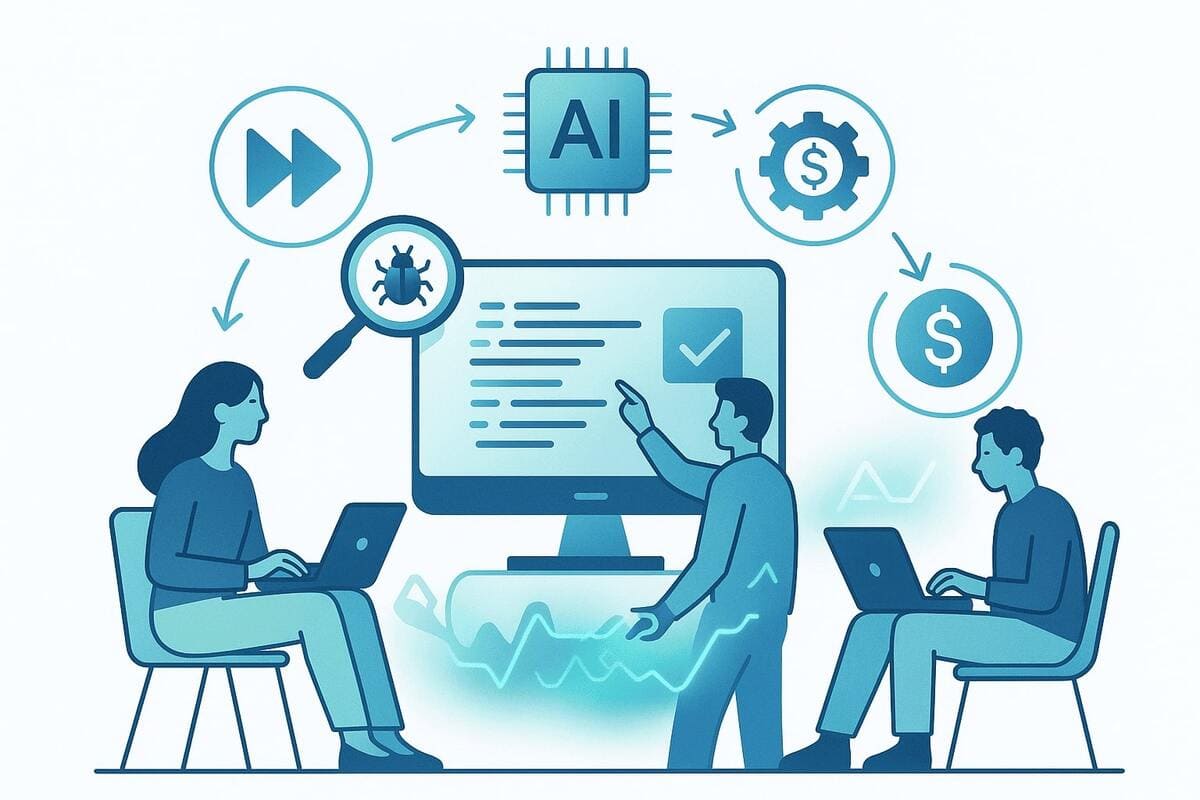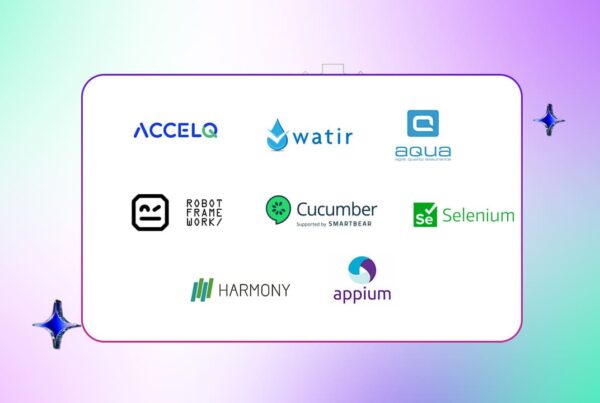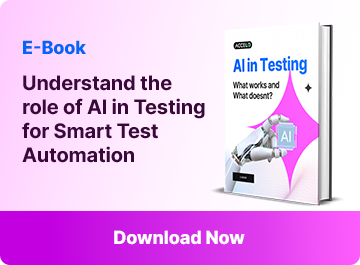A Tester’s Guide to Surviving Hyperautomation

Consider this scenario: A QA professional arrives at work to discover an AI system has automated 70% of their test cases overnight.
This isn’t speculation. It reflects the current operational reality in enterprise QA.
According to industry research, hyperautomation continues as a top strategic trend. Quality assurance professionals face a critical decision: evolve into strategic quality architects or risk professional obsolescence.
Understanding Hyperautomation in Testing Context
Hyperautomation represents a significant advancement beyond traditional test automation. It combines AI, machine learning, RPA, and advanced analytics to create testing systems that operate autonomously, learn from previous executions, and adapt to changing application environments.
While conventional automation simply executes predefined scripts, hyperautomation creates intelligent workflows capable of learning and making decisions with minimal human intervention.
The Evolution of Testing in the Hyperautomation Era
Traditional automation accelerates test execution. Hyperautomation takes this further by enabling intelligent systems to manage the entire testing lifecycle – selecting appropriate tests, executing them efficiently, and analyzing results without constant human oversight.
Automation vs Hyperautomation – What’s the Difference?
The move from automation to hyperautomation isn’t just a step up in speed. It’s a new way of thinking, where smart systems take over the heavy lifting and let QA teams focus on what really matters.
| Stage | Primary Focus | Core Technologies | QA Role Shift | Decision-Making | Maintenance Overhead |
|---|---|---|---|---|---|
| Manual Testing | Human-driven test execution and defect finding | Spreadsheets, bug trackers | Manual tester executing cases | Fully human | High |
| Test Automation | Scripted execution of predefined tests | Selenium, Appium, JUnit, TestNG | Automation engineer writing & maintaining scripts | Predefined logic only | Medium to High |
| Hyperautomation | AI-driven orchestration of the testing lifecycle | AI/ML, RPA, Predictive Analytics, No-Code | QA architect designing strategy and governance | Real-time, adaptive with AI insight | Low (AI-based self-healing, adaptability) |
The transition from automation to hyperautomation represents a fundamental shift in quality assurance operations.
Benefits of Hyperautomation in Testing
The market for hyperautomation technologies is projected to reach $2.1 billion by 2029 as organizations seek to optimize processes and gain competitive advantages.
Quantifiable Benefits for Testing Teams
The tangible benefits of hyperautomation include:
- Accelerated Testing Cycles: Organizations report 40-60% faster testing cycles
- Enhanced Defect Detection: Hyperautomation AI-powered testing identifies 30% more defects earlier in development
- Operational Efficiency: By 2024, organizations could reduce operational costs by 30% through hyperautomation (Source: Gartner, 2021)

A top American financial services company with over $1.71 trillion in assets used ACCELQ’s hyperautomation and got amazing results: 2.3+ million test executions through 378 CI/CD suites and 72% savings in Quality costs., These hyperautomation examples highlight the measurable impact it delivers at scale, as they can transform multi-day manual testing into automated regression tests that run in just hours.
From Cost Center to Strategic Asset
Testing has traditionally been viewed as a necessary cost center and potential bottleneck. Hyperautomation transforms this perception by:
- Enabling Continuous Quality: Automated validation occurs throughout development cycles
- Providing Predictive Insights: Analytics identify potential problem areas before they impact the business
- Supporting Strategic Decisions: Quality metrics inform leadership decision-making
- Enhancing Professional Growth: QA professionals focus on complex problems like designing test strategies, analyzing quality trends, improving user experience, and aligning testing with business goals, while automation handles routine tasks.
It’s important to understand how hyperautomation works and the key components of hyperautomation. It is a mix of tech that works together:
- RPA Bots: Do the mundane tasks like data setup
- AI-driven algorithms: Figure out what needs testing and how
- Analytics: Show practical insights through dashboards
- Integration: Connect testing with development pipelines
ACCELQ gets this right with their no-code platform. Their AI actually understands how test steps relate to business processes, reducing work time by 70%.
The Tester’s Evolving Role
Hyperautomation doesn’t eliminate testing roles but transforms them into higher-value positions focused on strategy and quality architecture.
From Test Execution to Quality Architecture
As hyperautomation handles routine testing activities, QA professionals evolve into:
- Quality Engineers: Building test frameworks instead of individual test cases
- Test Strategists: Designing effective Test Selection approaches
- Quality Consultants: Guiding development teams toward quality-first practices
- Automation Architects: Creating comprehensive automation strategies
To succeed in this environment, professionals need skills in AI concepts, data analysis, and strategic quality planning.
Implementing a Hyperautomation Strategy
High-Value Application Areas
Hyperautomation delivers exceptional results in specific testing domains:
- Regression Testing: Intelligent selection and execution based on code changes
- Test Data Management: Automated generation and management of test data assets
- Environment Configuration: Streamlined setup of testing environments
- Cross-Browser Testing: Efficient execution across multiple browser platforms
- Performance Testing: Resource optimization based on actual usage patterns
Tool Selection Considerations
When evaluating hyperautomation solutions, organizations should assess:
- Integration capabilities with existing technology stacks
- Scalability to accommodate growing testing requirements
- AI/ML capabilities for reducing maintenance efforts
- Analytics features provide actionable quality insights
| Tool Type | Hyperautomation use cases | Real-world benefit |
|---|---|---|
| AI Platforms (ACCELQ) | Testing web/mobile/API/desktop | 70% faster setup; non-coders can build tests |
| RPA Tools | Test data preparation | Handles mundane activities; works with legacy systems |
| AI Analytics | Test picking, bug prediction | Tells you what to test; spots bug hotspots |
| Record/Playback | Quick workflow automation | Gets business executives involved |
| Self-Healers | Apps with changing UIs | Fewer fixes when interfaces change |
Implementation Approach
A structured implementation strategy includes:
- Begin with a focused pilot project demonstrating measurable ROI
- Develop organizational expertise through hands-on implementation
- Optimize testing processes to leverage hyperautomation capabilities
- Expand implementation systematically across testing functions
- Implement continuous assessment and improvement processes
Future-Proofing Testing Careers
As testing methodologies evolve, quality assurance professionals can position themselves for success by:
- Knowledge Sharing: Educating teams on hyperautomation principles and practices
- Technology Adoption: Embracing emerging technologies and approaches
- Value Demonstration: Quantifying and Communicating Hyperautomation Benefits
- Community Development: Establishing networks for sharing hyperautomation practices
- Ongoing Education: Maintaining awareness of industry developments
Proactive QA professionals are leading this transformation and redefining their roles. They’re developing skills that complement automated systems: strategic thinking, business domain expertise, and understanding of user needs.
Career advancement in this environment means moving beyond test execution to focus on quality strategy that aligns with business objectives while leveraging automation for repetitive work.
Hyperautomation presents both challenges and opportunities for testing professionals. By understanding the technology, developing relevant skills, and adopting strategic approaches, testers can transform their role from test executors to quality leaders.
Want to see how hyperautomation can transform your QA function? Contact us to know how ACCELQ’s AI-driven test automation platform powers hyperautomation—cutting test effort by 70% with zero scripting.
Nishan Joseph
VP Sales Engineering
Nishan is a tech strategist with expertise in Test Automation and roles at giants like TCS, Microfocus, and Parasoft. At ACCELQ, he champions Strategic Alliances, cultivating global tech partnerships. Educated at Leeds University and Symbiosis Pune, he also possesses an engineering background from Bangalore.
You Might Also Like:
 Top AI Testing Frameworks QA Engineers Must Know in 2026
Top AI Testing Frameworks QA Engineers Must Know in 2026
Top AI Testing Frameworks QA Engineers Must Know in 2026
 A Tester’s Guide to Surviving Hyperautomation!
A Tester’s Guide to Surviving Hyperautomation!
A Tester’s Guide to Surviving Hyperautomation!
 AI in DevOps: The Hidden QA Advantages Teams Miss Today
AI in DevOps: The Hidden QA Advantages Teams Miss Today


































